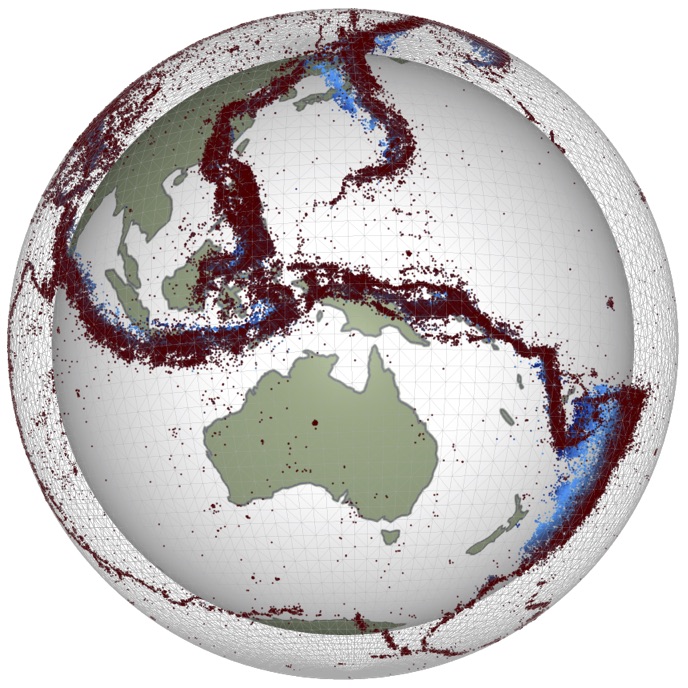Temperature-dependent viscosity convection, Cylindrical domain (benchmark)#
This is a simple example in which we try to instantiate two solvers on the mesh and have them use a common set of variables.
We set up a v, p, T system in which we will solve for a steady-state T field in response to thermal boundary conditions and then use the steady-state T field to compute a stokes flow in response.
The next step is to add particles at node points and sample back along the streamlines to find values of the T field at a previous time.
This has a free-slip lower boundary and a fixed upper boundary (simplifies the null space, and the lid is stagnant anyway)
# to fix trame issue
import nest_asyncio
nest_asyncio.apply()
import petsc4py
from petsc4py import PETSc
import underworld3 as uw
from underworld3.systems import Stokes
from underworld3 import function
import numpy as np
import sympy
# Parameters
r_o = 1.0
r_i = 0.5
res = 1 / 24
Rayleigh = 1.0e6 / (r_o - r_i) ** 3
log10_delta_eta = 4
# Visualisation
import pyvista as pv
pv.global_theme.background = "white"
pv.global_theme.window_size = [750, 250]
pv.global_theme.anti_aliasing = "msaa"
pv.global_theme.jupyter_backend = "trame"
pv.global_theme.smooth_shading = True
meshdisc = uw.meshing.Annulus(
radiusOuter=r_o,
radiusInner=r_i,
cellSize=float(res),
qdegree=3,
)
#
meshdisc.vtk("tmp_ann_mesh.vtk")
v_soln = uw.discretisation.MeshVariable("U", meshdisc, meshdisc.dim, degree=2)
p_soln = uw.discretisation.MeshVariable("P", meshdisc, 1, degree=1, continuous=True)
t_soln = uw.discretisation.MeshVariable("T", meshdisc, 1, degree=3)
meshr = uw.discretisation.MeshVariable(r"r", meshdisc, 1, degree=1)
radius_fn = sympy.sqrt(
meshdisc.rvec.dot(meshdisc.rvec)
) # normalise by outer radius if not 1.0
unit_rvec = meshdisc.X / (radius_fn)
gravity_fn = radius_fn
# Some useful coordinate stuff
x, y = meshdisc.CoordinateSystem.X
ra, th = meshdisc.CoordinateSystem.xR
hw = 1000.0 / res
surface_fn_a = sympy.exp(-(((ra - r_o) / r_o) ** 2) * hw)
surface_fn = sympy.exp(-(((meshr.sym[0] - r_o) / r_o) ** 2) * hw)
base_fn_a = sympy.exp(-(((ra - r_i) / r_o) ** 2) * hw)
base_fn = sympy.exp(-(((meshr.sym[0] - r_i) / r_o) ** 2) * hw)
free_slip_penalty_upper = v_soln.sym.dot(unit_rvec) * unit_rvec * surface_fn
free_slip_penalty_lower = v_soln.sym.dot(unit_rvec) * unit_rvec * base_fn
# Create Stokes object
stokes = Stokes(
meshdisc,
velocityField=v_soln,
pressureField=p_soln,
solver_name="stokes",
)
# Set solve options here (or remove default values
# stokes.petsc_options.getAll()
# stokes.petsc_options.delValue("ksp_monitor")
# stokes.petsc_options["snes_test_jacobian"] = None
# T dependent visc
delta_eta = 10**log10_delta_eta
stokes.petsc_options["snes_rtol"] = 1 / delta_eta
viscosity = delta_eta * sympy.exp(-sympy.log(delta_eta) * t_soln.sym[0])
stokes.constitutive_model = uw.constitutive_models.ViscousFlowModel
stokes.constitutive_model.Parameters.viscosity = viscosity
stokes.penalty = 0.0
stokes.saddle_preconditioner = 1.0 / viscosity
# Velocity boundary conditions
stokes.add_dirichlet_bc((0.0, 0.0), "Upper", (0, 1))
# stokes.add_dirichlet_bc((0.0,0.0), "Lower", (0,1))
# Buoyancy force RHS plus free slip surface enforcement
buoyancy_force = Rayleigh * t_soln.sym[0] * unit_rvec * (1.0 - base_fn)
penalty_terms = 10000000 * free_slip_penalty_lower
stokes.bodyforce = buoyancy_force - penalty_terms
# Create adv_diff object
# Set some things
k = 1.0
h = 0.0
adv_diff = uw.systems.AdvDiffusionSLCN(
meshdisc,
u_Field=t_soln,
V_fn=v_soln,
solver_name="adv_diff",
)
adv_diff.constitutive_model = uw.constitutive_models.DiffusionModel
adv_diff.constitutive_model.Parameters.diffusivity = k
adv_diff.theta = 0.5
# Define T boundary conditions via a sympy function
import sympy
init_t = 0.9 + 0.05 * (sympy.cos(sympy.pi * th / 2)) * sympy.cos(
0.5 * np.pi * (ra - r_i) / (r_o - r_i)
)
adv_diff.add_dirichlet_bc(1.0, "Lower")
adv_diff.add_dirichlet_bc(0.0, "Upper")
with meshdisc.access(t_soln):
t_soln.data[...] = uw.function.evaluate(init_t, t_soln.coords, meshdisc.N).reshape(
-1, 1
)
with meshdisc.access(meshr):
meshr.data[:, 0] = uw.function.evaluate(
sympy.sqrt(x**2 + y**2), meshdisc.data, meshdisc.N
) # cf radius_fn which is 0->1
# check the stokes solve is set up and that it converges
stokes.solve(zero_init_guess=True)
# Check the diffusion part of the solve converges
adv_diff.solve(timestep=0.1 * stokes.estimate_dt())
# adv_diff
# check the mesh if in a notebook / serial
if uw.mpi.size == 1:
import pyvista as pv
import underworld3.visualisation as vis
pvmesh = vis.mesh_to_pv_mesh(meshdisc)
pvmesh.point_data["V"] = vis.vector_fn_to_pv_points(pvmesh, v_soln.sym)
pvmesh.point_data["T"] = vis.scalar_fn_to_pv_points(pvmesh, t_soln.sym)
points = vis.meshVariable_to_pv_cloud(t_soln)
points.point_data["Tp"] = vis.scalar_fn_to_pv_points(points, t_soln.sym)
point_cloud = pv.PolyData(points)
# point sources at cell centres
subsample = 2
cpoints = np.zeros((meshdisc._centroids[::subsample, 0].shape[0], 3))
cpoints[:, 0] = meshdisc._centroids[::subsample, 0]
cpoints[:, 1] = meshdisc._centroids[::subsample, 1]
cpoint_cloud = pv.PolyData(cpoints)
pvstream = pvmesh.streamlines_from_source(
cpoint_cloud,
vectors="V",
integrator_type=2,
integration_direction="forward",
compute_vorticity=False,
max_steps=100,
surface_streamlines=True,
)
pl = pv.Plotter(window_size=(750, 750))
pl.add_mesh(pvmesh, "Gray", "wireframe")
# pl.add_mesh(
# pvmesh, cmap="coolwarm", edge_color="Black",
# show_edges=True, scalars="T", use_transparency=False, opacity=0.5,
# )
pl.add_points(
point_cloud,
cmap="coolwarm",
render_points_as_spheres=False,
point_size=3,
opacity=0.33,
)
pl.add_mesh(pvstream, opacity=0.5)
pl.add_arrows(pvmesh.points, pvmesh.point_data["V"], mag=1.0e-4)
# pl.add_points(pdata)
pl.show(cpos="xy")
def plot_T_mesh(filename):
if uw.mpi.size == 1:
import pyvista as pv
import underworld3.visualisation as vis
pvmesh = vis.mesh_to_pv_mesh(meshdisc)
pvmesh.point_data["V"] = vis.vector_fn_to_pv_points(pvmesh, v_soln.sym)
pvmesh.point_data["T"] = vis.scalar_fn_to_pv_points(pvmesh, t_soln.sym)
# point sources at cell centres
cpoints = np.zeros((meshdisc._centroids.shape[0], 3))
cpoints[:, 0] = meshdisc._centroids[:, 0]
cpoints[:, 1] = meshdisc._centroids[:, 1]
cpoint_cloud = pv.PolyData(cpoints)
pvstream = pvmesh.streamlines_from_source(
cpoint_cloud,
vectors="V",
integrator_type=45,
integration_direction="forward",
compute_vorticity=False,
max_steps=100,
surface_streamlines=True,
)
points = vis.meshVariable_to_pv_cloud(t_soln)
points.point_data["T"] = vis.scalar_fn_to_pv_points(points, t_soln.sym)
point_cloud = pv.PolyData(points)
pl = pv.Plotter(window_size=(750, 750))
pl.add_mesh(
pvmesh,
cmap="coolwarm",
edge_color="Gray",
show_edges=True,
scalars="T",
use_transparency=False,
opacity=0.5,
)
pl.add_points(
point_cloud,
cmap="coolwarm",
render_points_as_spheres=False,
point_size=10,
opacity=0.5,
)
pl.add_mesh(pvstream, opacity=0.4)
pl.remove_scalar_bar("T")
pl.remove_scalar_bar("V")
pl.screenshot(
filename="{}.png".format(filename),
window_size=(1280, 1280),
return_img=False,
)
# pl.show()
pl.close()
pvmesh.clear_data()
pvmesh.clear_point_data()
pv.close_all()
t_step = 0
# Convection model / update in time
##
## There is a strange interaction here between the solvers if the zero_guess is
## set to False
##
expt_name = f"output/Ra1e6_cyl_eta1e{log10_delta_eta}"
for step in range(0, 1000):
stokes.solve(zero_init_guess=True)
delta_t = 2.0 * stokes.estimate_dt()
adv_diff.solve(timestep=delta_t, zero_init_guess=True)
# stats then loop
tstats = t_soln.stats()
if uw.mpi.rank == 0:
print("Timestep {}, dt {}".format(step, delta_t))
# print(tstats)
if t_step % 5 == 0:
plot_T_mesh(filename="{}_step_{}".format(expt_name, t_step))
t_step += 1
# savefile = "{}_ts_{}.h5".format(expt_name,step)
# meshdisc.save(savefile)
# v_soln.save(savefile)
# t_soln.save(savefile)
# meshdisc.generate_xdmf(savefile)
savefile = “output_conv/convection_cylinder.h5”.format(step) meshdisc.save(savefile) v_soln.save(savefile) t_soln.save(savefile) meshdisc.generate_xdmf(savefile)
if uw.mpi.size == 1:
import pyvista as pv
import underworld3.visualisation as vis
pvmesh = vis.mesh_to_pv_mesh(meshdisc)
velocity_points = vis.meshVariable_to_pv_cloud(stokes.u)
velocity_points.point_data["V"] = vis.vector_fn_to_pv_points(velocity_points, stokes.u.sym)
points = vis.meshVariable_to_pv_cloud(t_soln)
points.point_data["T"] = vis.scalar_fn_to_pv_points(points, t_soln.sym)
point_cloud = pv.PolyData(points)
pl = pv.Plotter(window_size=(750, 750))
pl.add_arrows(velocity_points.points, velocity_points.point_data["V"], mag=1e-4, opacity=0.75)
# pl.add_arrows(arrow_loc2, arrow_length2, mag=1.0e-1)
pl.add_points(
point_cloud,
cmap="coolwarm",
render_points_as_spheres=True,
point_size=7,
opacity=0.25,
)
pl.add_mesh(pvmesh, "Black", "wireframe", opacity=0.75)
pl.show(cpos="xy")
